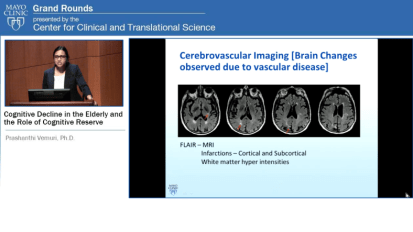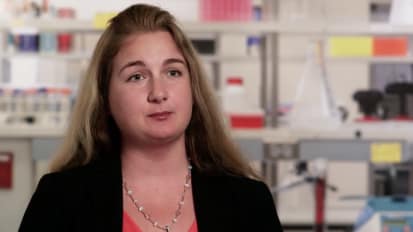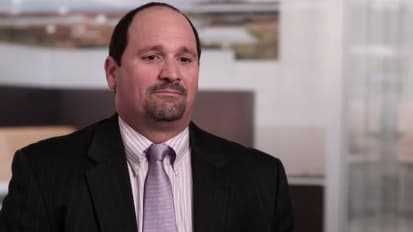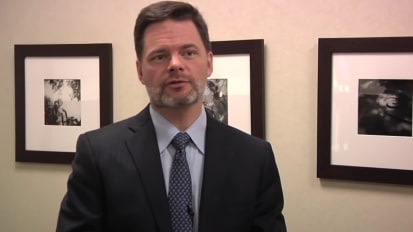Chapters
Transcript
RONALD K. REEVES: Good afternoon. I drew the short straw having to follow a fabulous talk, but this will be kind of a little bit of a shift from the earlier talk. Thanks, everyone, for being here. My name is Ron Reeves. I'm one of the staff physicians here at Mayo. I'm going to put a plug in for the talk right next door. Ray Onders is a visiting clinician who is an expert in diaphragm pacing, and that'll be an excellent talk as well. And so if anyone is interested in diaphragm pacing, don't miss his talk.
But I'm going to talk about some work we've been doing over the last few years to establish international, non-traumatic spinal cord injury study group, and begin to look at outcomes across centers, across continents even for non-traumatic spinal cord injury. And so I thank you for spending some time here. For those of you who aren't from Rochester, this is Saint Mary's Hospital, which is where the major neuro trauma center is and the neurologic and neurosurgical practices. The third floor-- the Mary Brigh building-- where the star is is where the rehab unit is, and where most of my practice is.
So over the next 30 or so minutes, I'll talk about a variety of things related to non-traumatic spinal cord injury. Some introductory information about non-traumatic spinal cord injury, I'll talk a little bit about some of the single center work that we've done here in the early 2000 time frame. And then I'll wrap up talking about the multi-center work that we're doing now.
So just from a definition point of view, a non-traumatic spinal cord injury is a condition unrelated to an external force or event that affects the spinal cord or the roots. So a disk herniation causing a cauda equina syndrome, a cord tumor. Those kinds are things are non-traumatic spinal cord injuries.
Thus far, the literature for non-traumatic spinal cord injury has been primarily focused on single center studies. So Bill McKinley in Virginia has done quite a bit about a decade ago. And those studies have shown across different centers that, in general, people with non-traumatic spinal cord injury are older than people with traumatic spinal cord injury.
They're more likely to be female. So again, there's still a male predominance, but a higher percentage of women have non-traumatic spinal cord injuries than traumatic. Social support is better. People are often married. Incomplete spinal cord injury is almost universal, so complete is quite rare. And in general, people have paraplegia rather than cervical level or tetraplegia.
Both non-traumatic and traumatic spinal cord injury tends to benefit similarly from inpatient rehabilitation. There is some work from Peter New in Australia suggesting that the incidence of non-traumatic spinal cord injury may actually be greater than traumatic spinal cord injury. But that hasn't been duplicated in other population-based studies. But with the aging of the population, then it's reasonable to think as well that non-traumatic spinal cord injury may be increasing over the next decade or two.
There are a variety of subgroups. So just as for traumatic spinal cord injury we think about mechanism of injury-- motor vehicle accidents, falls, violence, and sports-- there are numerous subgroups in non-traumatic injuries. So degenerative or musculoskeletal causes being an important one in many practices. cancer-related causes-- intramedullary, extramedullary, metastatic disease-- vascular-related causes-- either ischemia, hemorrhage, malformations, fistulae-- inflammatory problems such as transverse myelitis, infectious causes-- not so common here, but we'll see from some of the other countries a more common problem-- and metabolic things-- copper deficiency, b-12 deficiency, et cetera. Those are just some of the categories.
So like many centers, we have a database of patients who have had injuries affecting the spinal cord and conditions affecting the spinal cord. Our database goes back to 1972. For the first many years, it's paper-based, and so that's not quite as easy to search as the more recent electronic versions.
But we have over 2,500 people in the database. We have data collection specialists who abstract the medical record, and put that into the database. We have a classification system which is very similar to many classification systems. And over time, the database has evolved to remain relevant and updated and current.
The single center work that we did in the early 2000 is based on this basic patient population. So almost 1,500 people with traumatic and non-traumatic spinal cord injury dismissed from our rehabilitation unit between 1995 and 2007. The next several slides will all come from that patient population. And
At this center, about 70% of the patients that we serve have a non-traumatic spinal cord injury. And what we can see is that the group of degenerative patients are musculoskeletal cause injuries in the non-traumatic group, for us, is as large as our traumatic patient population.
If we break down just the non-traumatic spinal cord injured patients that we served in this time interval-- between 2005 and 2007-- about 45% of them were musculoskeletal causes. 30% of that 1,449 patients had cancer as the cause for their myolapathy. 17% had vascular causes. 5% other miscellaneous things-- metabolic, for example, congenital things. And just 2% either inflammatory or infectious problems. Now we'll come back to this graph later in the talk, and contrast some of the other centers that we're collaborating with in the international studies.
We know that the mechanism by which the neurologic deficit is acquired also has a relationship with survival and prognosis. So, not surprisingly, cancer-- shown in the yellow line here-- has a relatively poor survival prognosis in comparison to trauma-- the orange line at the very top. And then several different etiologies in the middle have about the same survival. Now keep in mind the patient population in all the lines other than orange is older. And so this isn't age adjusted. And so the survival would be a bit different just based on age.
Now if we look at cancer-related myelopathy or non-traumatic spinal cord injury, one of the things we see, as you would expect, is that metastatic disease has a substantially worse prognosis than primary intramedullary lesions or extramedullary lesions who survive at a rate about equivalent to most other causes of non-traumatic spinal cord injury. So stenosis for example. The survival of the primary cancer patients is about the same.
Interestingly, but not surprisingly, functional status, which is a proxy measure for neurologic completeness or incompleteness, also predicts survival. So using the functional independence measure, a higher FIM score at the time of discharge from inpatient rehabilitation has a better overall survival than a lower FIM score. And that's across patient groups.
So this was a very well done study by one of our residents a number of years ago. Surveyed almost 500 people-- 400 and something-- asking about quality of life using the satisfaction with life measure. And what we find is whether the mechanism of myelopathy is traumatic or non-traumatic, satisfaction with life several years later is comparable between patient populations.
That work and the work at other centers brought several of us together in Durban, South Africa at the International Spinal Cord Society meeting in 2008. And we began a collaborative approach to collect and examine data from our centers. So the rest of the slides are going to refer to that work in particular.
Important to note that the centers participating are not randomly selected. They're are centers that are interested in non-traumatic spinal cord injury. And so there's some, perhaps, bias in what we see. We did intentionally try to select a mixture of developing and developed countries. In part, to try to understand the diversity of non-traumatic spinal cord injury.
To ensure that the centers had some reasonable volume, we asked that they have at least 50 non-traumatic patients over the course of a three-year time period. And despite quite a bit of effort, we were unable to find a center from South America that was willing to participate. But otherwise, at least initially, we had one from every continent, obviously not Antarctica. But
So these are our collaborators. Andrea Townsend is in Canada in Vancouver. Eimear Smith in Ireland. Marcel Post in the Netherlands. Inga Eriks-Hoogland in Switzerland. Zaheer Gil from Pakistan. Dr. Gupta from India. Rob Campbell from South Africa. He was only able to participate in some of the initial survey work. And so subsequent to the beginning of the project, he had to drop out. Peter New from Australia has been the leader of a lot of the work, and I really owe quite a bit of gratitude to Peter for his energy, which is boundless based on the number of e-mails we get.
What were some of the initial goals? So what we wanted to do was to basically confirm and expand the single center findings. We wanted to try to begin to establish some outcomes benchmarks across centers. And ultimately, the more we can understand, hopefully, we can improve care and outcomes for patients.
So initially, given the transcultural nature of the studies, we really needed to understand each of the centers. And so the first thing we did was conduct some baseline surveys of the centers to establish or at least understand what we would be comparing as we began to look at outcomes. So the surveys were developed based on expert opinion and literature review.
And two things were really the focus of the survey. So one of which was to understand the way the systems were set up. And the other was to look at what are the barriers and the challenges that individual systems may be facing.
Now there are a lot of similarities not surprisingly. All of the units have relatively similar philosophies as it relates to admitting pretty much all patients with spinal cord related conditions. All the units have similar philosophies in terms of discharge, which is really the team and the patients decide on a collaborative basis when is the best time to make the transition. Now that is always influenced by external factors.
There's a fizzy asterisk as a medical director for all of the units. That may be a little bit of a bias because that's often who attends the [INAUDIBLE] meetings and things. Staffing across cultures and across continents and bed availability affects the ability to receive admissions. And the availability of suitable post-discharge options affects the discharge across all the study centers.
So this is an overview, and it's a little bit of a busy slide. But there are just a few highlights. Across the centers, there's a variety of compensation mechanisms. Most every center receives some degree of compensation from the government except for the Netherlands, which is a purely private insurance-based unit. So pretty much half the centers have an acute care link. We're embedded in an acute care hospital. Several of them are freestanding.
Interestingly, only three of the centers have formal admission criteria that are written out, so our center here, which is the USA, the South African center, and the Canadian center, which is in Vancouver. Otherwise, none of the other centers have formal written admission criteria. So that was a little bit of a surprise.
On average, most of the units have around 20 spinal cord beds. The Swiss center is a mixture of acute care and rehabilitation all in the same center with what you'll see is a very long length of stay. So their bed number is quite a bit different. In general, most tend to admit between 50 and 150 patients a year. We sort of stand out as having 800 patients per year come through our unit. And that's with all patients coming through the unit, not just the spinal cord patients.
Looking at staffing there were wide ranges of staffing. But on average for 10 beds, there's about half time physiatrist, or for 20 beds, there'd be one physiatrist. There's one resident on average-- or the median staffing-- one resident for 10 beds across the centers. Two nursing staff per 10 beds, two PTs, basically two OTs. 75% effort social worker for 10 beds. And a 40% effort psychologist for 10 beds.
Now there was a fairly wide range. In Italy, for example, there's 1.3 physiatrists for 10 beds. Whereas in Ireland, there's a quarter of a physiatrist for 10 beds. For the range of physical therapists in Pakistan, one physical therapist for 10 beds. In Italy, 2.5 or 2.6 physical therapists for 10 beds. OT ranges from two OTs in Australia for 10 beds to none in Pakistan.
Social workers, just 1/10 of a social worker in Italy to almost a full time social worker in Ireland. Psychology ranges from 20% effort to full time. And hours of therapy per day ranges from two to five across these centers.
Median therapy time, 2.5 hours per day range, as I mentioned, two to five hours per day. So every center except for the USA and Switzerland provide therapy just five days a week. So both our center and in Switzerland, therapies have all seven days per week.
Group therapy is very common at every other center as a standard part of all the practices. Some centers have four or five or six different groups that they have that they run on a regular basis. So we're the one exception to that. We have very few established groups that run on a regular basis. And all the sites except for one offered some degree of formal spinal cord injury education to the patient, to the family. But there was one site that didn't offer any.
I bet this can't be seen in the back of the room, but I'll kind of boil it down a little bit. Across the board, every unit had a psychiatrist available. Every unit had an orthotist available. And every unit had a dietician available to see the patients. About half of the units had a neuropsychologist, peer mentors, or recreation therapy or vocational therapy. In very few-- only a couple of units-- had a sexual function therapist or music therapy.
As we start to think about outcomes, there are a few caveats. There's a wide range of centers. Very different funding relationships between the centers and their payer source. We all have varying case mixes, and staffing and therapy delivered is rather diverse. And community resources also vary.
The retrospective study, which was our first attempt to try to understand this, looked at patients admitted to all of these centers between January of 2008 and December of 2010, so three years. Patients with non-traumatic spinal cord injury were included. Patients with other conditions-- diffuse disorders, such as multiple sclerosis or polio, conversion reaction-- none of those were included. We looked at clinical and demographic characteristics. And of course, there were a variety of quality and data checks to make sure that the information we had in the database was reliable.
We had 908 patients in total across these centers. South Africa was unable to provide any patients to participate. And Pakistan only had 12 patients with non-traumatic spinal cord injury over the study interval. And so subsequent slides won't show results from either of those two centers. We were the largest participating center with almost 300 patients over the three-year time interval. Most other centers had around 100 or so.
Median age very similar to the single center published studies, so 59 years. India, interestingly, has a much younger patient population with the median age of only 36, although other centers were about the same. 61% of the patients across the centers were men, in contrast to traumatic spinal cord injury where it's roughly 75% of the patients are men. But this was relatively common across the centers. Australia and India having a somewhat more gender balanced population. Why that is, we don't know.
About a quarter of the patients had their non-traumatic injury onset over a course of a day, and a little less than half had a fairly slow onset that came on over a month or more. And so for stenosis patients, it might be many months as they gradually changed. About 70% of the patients had paraplegia. This is relatively similar across centers. Australia most, almost 90% had paraplegia. Kinton The Canadian center and our center were slightly lower than that.
Length of stay. So this will be kind of a shock to those of us in the States. Median like to stay 43 days. USA, which is Mayo on the lower right hand corner, our median length of stay, 14 days for non-traumatic spinal cord injury. Quite a bit different. Switzerland median length of stay, 124 days. So very dramatic differences across centers and cultures, which has a lot to do with resources available. We have a relatively robust network of sub-acute providers. Other countries don't necessarily have those options available.
Interestingly, if we look at the age impairment scale, this is a five point injury severity grading scale with A injury grade being the most severe. That's a motor and sensory complete lesion. E being a lesion which has a normal motor and sensory exam, and the B and C and D categories are sort of in between. But what we see is about 20% of the patients admitted to these centers who came in with a motor and sensory complete injury-- an A-- at discharge, about 20% had converted to something else. That's perhaps a little bit higher than we would see in traumatic spinal cord injury.
In general though, as you can see, admission grade on the left, discharge grade on the top, most patients tend to stay the same or get a little bit better relatively stable overall. About 80% of the patients across all the centers discharged to home. Very small percent-- fortunately, less than 1%-- die during inpatient rehabilitation. Relatively few-- 5% or so-- go back to acute care because of a medical issue. And a few complete their inpatient rehab, and go back to acute care for elective kinds of things.
One of the great difficulties with comparing outcomes is that there's not a standard outcome measure available. So in the United States, we're reimbursed based on functional independence measure utilization. And so we use that of course. In other countries, reimbursement isn't necessarily linked to the outcome measure that's used. And so the Barthels and the SCIM and then there's a Netherlands specific measure as well. But across all of the centers in whatever measure we use, there are very significant changes between admission and discharge.
One of the things we do hope to do is to try to standardize outcome measures, perhaps to allow a little bit more robust comparison between centers. But that'll be kind of future work. So looking at the etiology, the mechanism for the non-traumatic injury. Across all centers, about 30% were from musculoskeletal degenerative causes, 17% from tumors, and about 11% from vascular ischemic lesions. Smaller percentages from other causes.
So just a few trivial things which are of interest. In Pakistan, 40% of the non-traumatic injuries that that center did see were from tuberculosis. In Switzerland, 40% of the injuries they care for are from vascular-related causes. Here in the States, about 33% of our cases were from musculoskeletal causes. That's similar in Ireland and Canada and the Netherlands. Similarly, over 30% of our cases are from cancer. That was similar in the Netherlands, Canada, and Switzerland. And surprisingly, what we weren't expecting is about 30% of the cases in India are from viral causes.
We showed this graph already. This was our experience from 1995 to 2007. So if we look at the 2008 to 2011 window, relatively similar distribution, although the degenerative musculoskeletal causes are a slightly smaller percentage. It was 45% in that 12 year period. In this three year period, it's slightly less than 40%. But still about 30% from cancer. Slightly more from vascular causes, so about 12% here.
Now, if we look at Australia, similar to some of the European centers, 34% of their causes are from vascular causes. A relatively higher percentage of infectious causes as well though. Relatively less cancer-related causes. In India, as I mentioned, 50% of their cases are from infectious, so viral being the largest group, but also tuberculosis being another very large contributing cause in India.
What have we seen so far? We've seen that as in the single center studies, non-traumatic spinal cord injury patients tend to be older. 60 versus roughly 40, which would be the mean age for traumatic spinal cord injury. About 40% or so of the non-traumatic spinal injury patients are female as opposed to only a quarter of traumatic spinal cord injury patients. Almost 90% have incomplete lesions versus about a little bit more than half of traumatic patients have incomplete lesion. And 70% have paraplegia. Again, quite a bit different from traumatic patients.
We saw marked variation in length of stay, and marked variation in the ideology. Now there are several limitations. This is retrospective. So we're at the mercy of what's available in the databases and in the medical records to review. The participating centers across the continents may not be representative of even those countries. And we're certainly probably not a just average everyday center here compared to every other place in the US. And so there's probably some bias.
The clinical outcome measures, as I mentioned, are different from center to center, which makes comparison difficult. And a 14-day average length of stay here in comparison to 124-day length of stay in Switzerland or 90 days in other centers, clearly there's something very different going on at those centers with those marked differences in length of stay. And we don't really understand that quite yet.
So that's the overview. Unfortunately, it kind of looks almost like this outside. And I'm very sorry for that. A few days ago it was like 65 degrees and sunny, and that would have been much nicer for everyone out of town to enjoy that. Fortunately, it isn't well below zero, and won't be so much snow that you won't be able to fly out. Thanks very much for your attention. And I appreciate the opportunity to talk. And I'm sure we have some time for questions, and yeah, we're in good shape. Thank you.
[APPLAUSE]
Ronald K. Reeves, M.D., presented at the Neurorehabilitation Summit a formation of an international study group focusing on nontraumatic spinal cord injuries, and the data that were gathered throughout.
Related Videos



